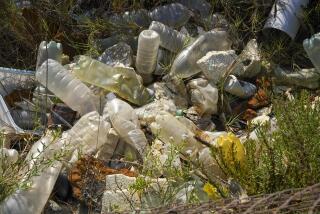Method Found for Recycling Juice Boxes : Environment: Two firms team up to prove that the containers can be reused--and that money can be made on it.
- Share via
SEATTLE — To a growing number of environmental activists, good things don’t always come in small packages, and that means trouble for some paper and packaging companies.
Take the septic juice box. The small containers, typically with little straws attached, have become enormously popular with children because they are easy to hold and contain just the right portions. Parents like them because they are virtually free of spills.
Yet they have been prohibited in Maine, and many state legislators and environmentalists from coast to coast are seeking to outlaw them as well.
Activists say the containers--made from layers of paperboard, plastic and foil--are difficult to tear down and thus hard to recycle, making the estimated 20 billion containers thrown away each year a threat to the nation’s overcrowded landfills.
To fight a tide of negative sentiment against this lucrative product and other paperboard boxes, Weyerhaeuser Co. of Tacoma, Wash., and Tetra Pak Inc., a subsidiary of the Swiss concern Tetra Pak International S.A. that is based in Shelton, Conn., have teamed up on a project to prove that the containers can be easily recycled--and that money can be made in the process.
The project is taking place at a Weyerhaeuser facility in Longview, Wash., near the Oregon border.
Weyerhaeuser officials point out that the technology used in the project--a kind of huge blender called a hydrapulper that cooks and reduces the paper to a watery pulp, then separates the pulp from the plastic and aluminum--has been in use for a long time.
“What’s different about this is that we’re using post-consumer waste”--milk cartons and juice containers collected by Tetra Pak at schools in the greater Portland area, plus cartons collected from the municipal solid-waste stream.
“These packages would otherwise end up in landfills,” said David Fish, a Weyerhaeuser researcher.
Weyerhaeuser estimates that about 17,000 tons of paperboard containers are used by consumers in Washington and Oregon each year.
During the first run of the pilot project, Tetra Pak went to schools and dairies in Portland and Vancouver, Wash., collecting about three tons of containers for the first test, including common milk cartons made from waxed paperboard.
The containers were easily broken down and recycled, becoming in their next incarnation what is called “corrugating medium”--the brown, corrugated paper that is used in making boxes. The boxes, in turn, will be used by Tetra Pak for shipping the liquid containers.
Other uses for the pulp include paper tissues, towels and toilet paper.
The polyethylene plastic and aluminum foil recovered in the process are to be turned over to plastic and aluminum manufacturers for use in other recycled products.
Roger Higle, a company spokesman, said the biggest problem in the way of successful recycling of the juice boxes and other liquid containers is not the technology or the expense in starting such a recycling program. He estimated a full-scale program would cost about $3 million, with most of that money going toward another hydrapulping machine.
“The major issue in doing this and the biggest problem to be solved is in the collection of a sufficient volume of cartons to do this on an ongoing basis,” Higle said. “There is a supply problem--or more accurately, a collection problem--that needs to be overcome.”
More to Read
Inside the business of entertainment
The Wide Shot brings you news, analysis and insights on everything from streaming wars to production — and what it all means for the future.
You may occasionally receive promotional content from the Los Angeles Times.








